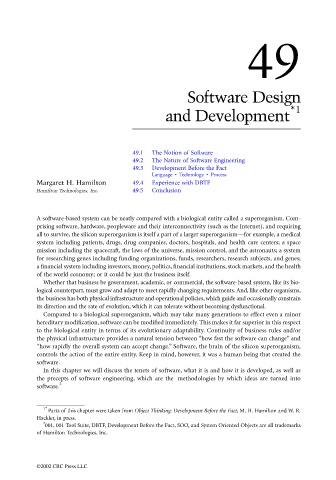Page 1206 - The Mechatronics Handbook
P. 1206
49
Software Design
and Development *1
49.1 The Notion of Software
49.2 The Nature of Software Engineering
49.3 Development Before the Fact
Language • Technology • Process
Margaret H. Hamilton 49.4 Experience with DBTF
Hamilton Technologies, Inc. 49.5 Conclusion
A software-based system can be neatly compared with a biological entity called a superorganism. Com-
prising software, hardware, peopleware and their interconnectivity (such as the Internet), and requiring
all to survive, the silicon superorganism is itself a part of a larger superorganism—for example, a medical
system including patients, drugs, drug companies, doctors, hospitals, and health care centers; a space
mission including the spacecraft, the laws of the universe, mission control, and the astronauts; a system
for researching genes including funding organizations, funds, researchers, research subjects, and genes;
a financial system including investors, money, politics, financial institutions, stock markets, and the health
of the world economy; or it could be just the business itself.
Whether that business be government, academic, or commercial, the software-based system, like its bio-
logical counterpart, must grow and adapt to meet rapidly changing requirements. And, like other organisms,
the business has both physical infrastructure and operational policies, which guide and occasionally constrain
its direction and the rate of evolution, which it can tolerate without becoming dysfunctional.
Compared to a biological superorganism, which may take many generations to effect even a minor
hereditary modification, software can be modified immediately. This makes it far superior in this respect
to the biological entity in terms of its evolutionary adaptability. Continuity of business rules and/or
the physical infrastructure provides a natural tension between “how fast the software can change” and
“how rapidly the overall system can accept change.” Software, the brain of the silicon superorganism,
controls the action of the entire entity. Keep in mind, however, it was a human being that created the
software.
In this chapter we will discuss the tenets of software, what it is and how it is developed, as well as
the precepts of software engineering, which are the methodologies by which ideas are turned into
2
software.
1*
Parts of this chapter were taken from Object Thinking: Development Before the Fact, M. H. Hamilton and W. R.
Hackler, in press.
2
001, 001 Tool Suite, DBTF, Development Before the Fact, SOO, and System Oriented Objects are all trademarks
of Hamilton Technologies, Inc.
©2002 CRC Press LLC

